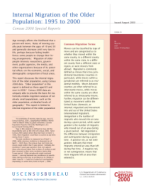Internal Migration of the Older Population: 1995 to 2000
Internal Migration of the Older Population: 1995 to 2000
Age strongly affects the likelihood that a person will move. Rates of moving usually peak between the ages of 18 and 30 and generally decrease until very late in life, perhaps because failing health forces some people to change their living arrangements. Migration of older people interests researchers, government, public agencies, the media, and other organizations because of its potential effects on the economic, social, and demographic composition of local areas.
This report discusses the internal migration of the older population, using Census 2000 data. “Older population” in this report is defined as those aged 65 and over in 2000. Census 2000 data are uniquely able to provide the basis for statistically reliable migration analysis of relatively small populations, such as the older population, at detailed levels of geography. This report is limited to internal migration of the older population between 1995 and 2000 and does not include movers from abroad.
The report first examines the general mobility of the older population — how many moved and what type of move they made — and compares different age groups among the older population. Given that mobility patterns of the older population may differ from those of the rest of the population, people 65 years and older are compared with those under age 65, especially the “near old,” who are aged 55 to 64. In addition, because women outnumber men at older ages, this report evaluates differences in mobility patterns between older men and women.
The second part of the report discusses the redistribution of the older population in the United States between 1995 and 2000 by examining net migration rates and flow numbers at the region, division, and state levels, in order to identify areas that experienced the largest net migration gain or loss of older people, as well as the most popular destinations and origins of older migrants. Finally, a map of county-level net migration rates complements the state-level migration analysis with a finer degree of geographic detail.
Table 1. Gross and Net Migration by Sex for the Population 5 Years and Over for the United States, Regions, and States: 2000
Table 2. Gross and Net Migration by Sex for the Population 5 Years and Over for Puerto Rico: 2000
Table 3. Gross and Net Migration by Age for the Population 5 Years and Over for the United States, Regions, and States: 2000
Table 4. Gross and Net Migration by Age for the Population 5 Years and Over for Puerto Rico: 2000
Table 5. State of Residence in 2000 by State of Residence in 1995 for the Population 5 to 64 Years: 2000
Table 6. Residence in 2000 by State of Residence in 1995 for the Population 65 Years and Over: 2000
Table 7. Puerto Rico-United States Migration for the Population 5 Years and Over by Age: 1995 to 2000
Others in Series
Publication
Publication
Publication









